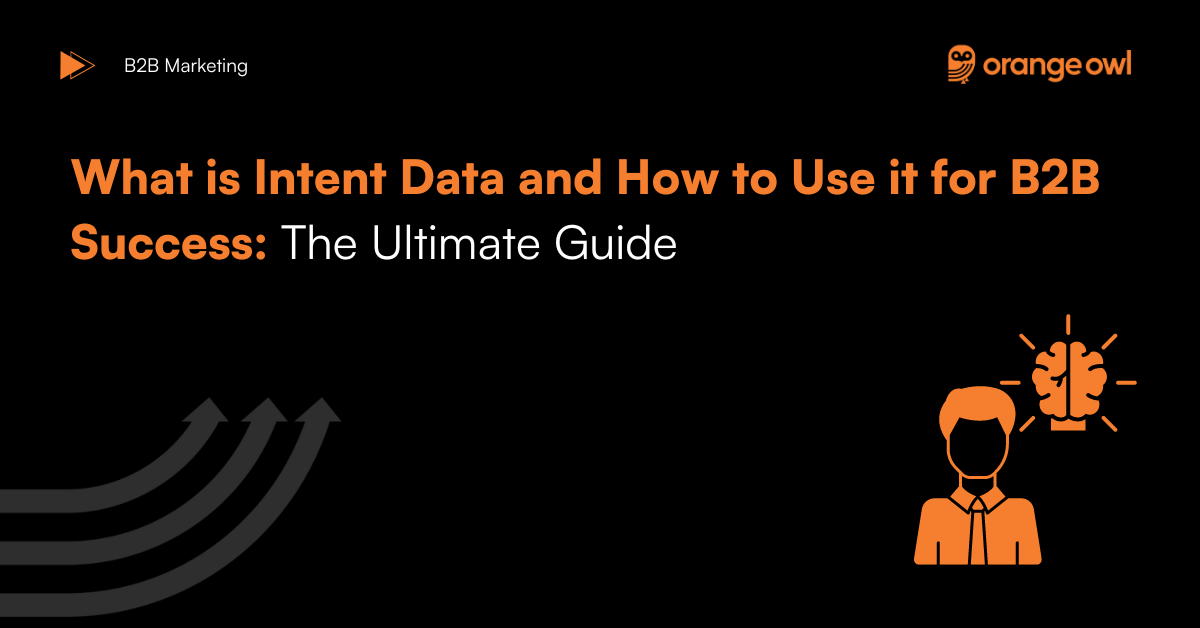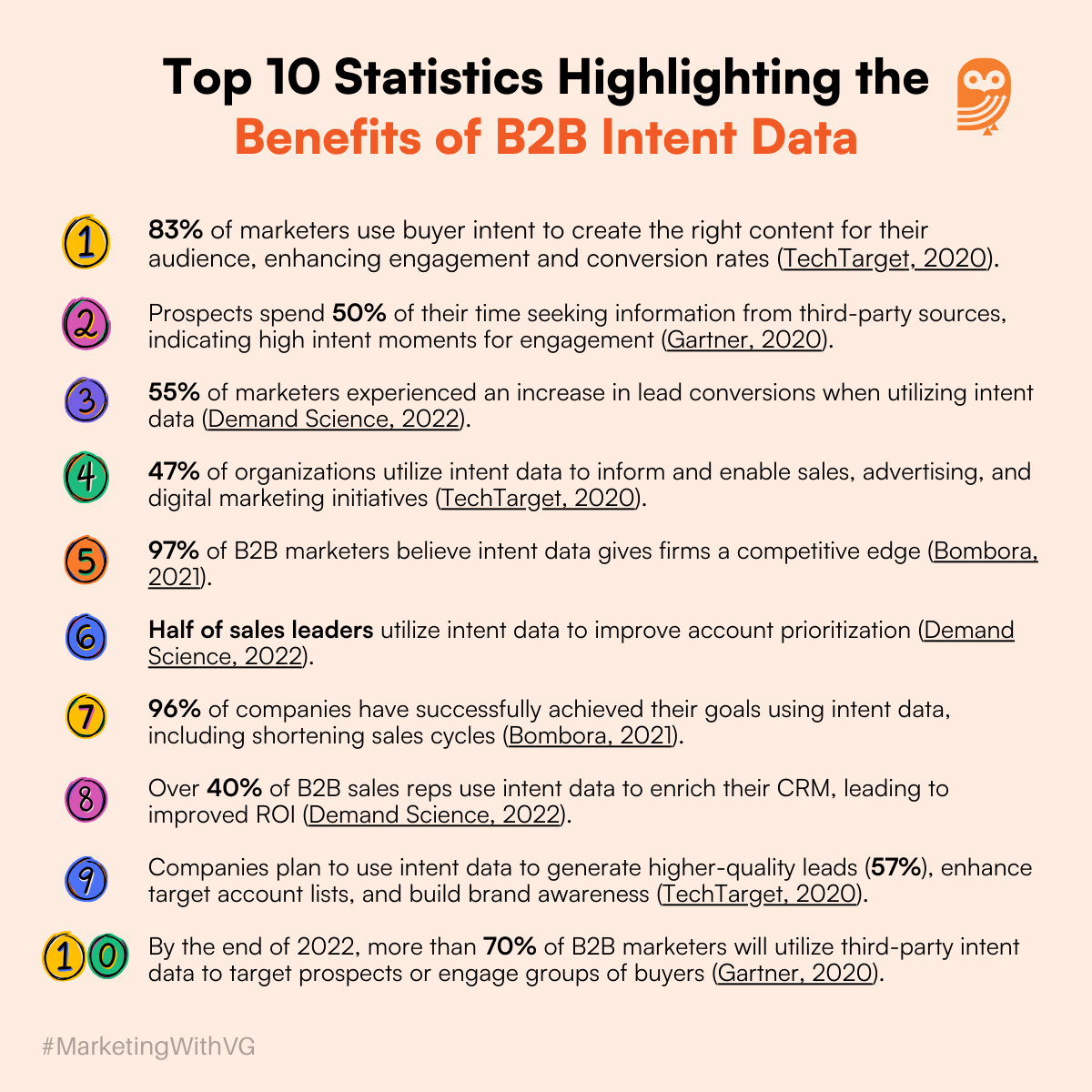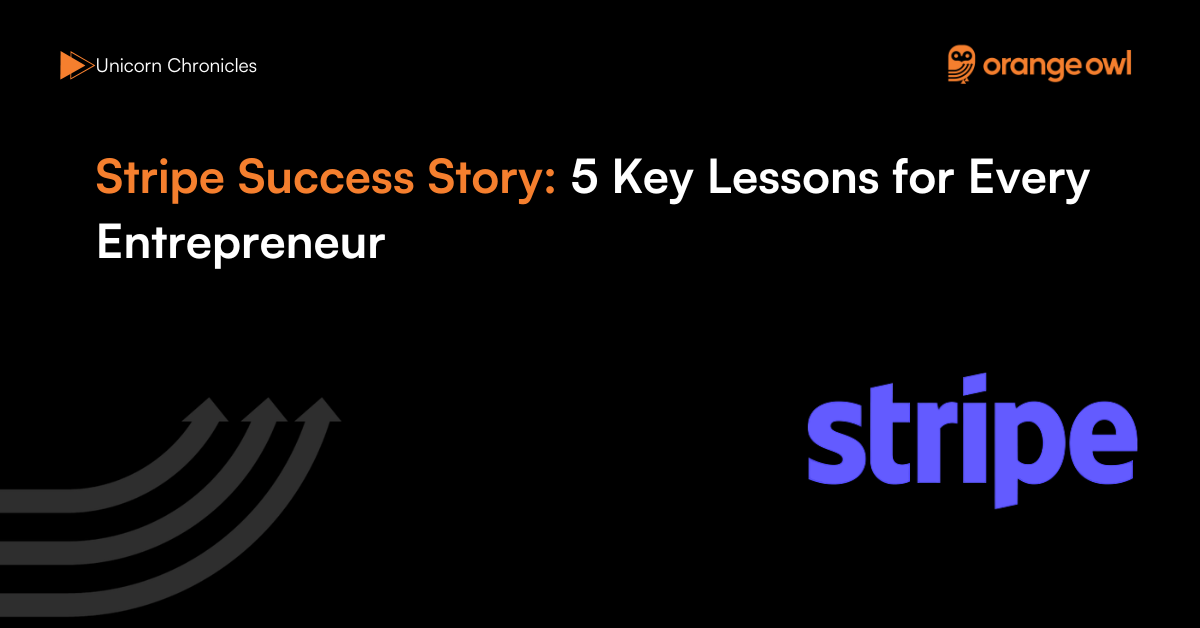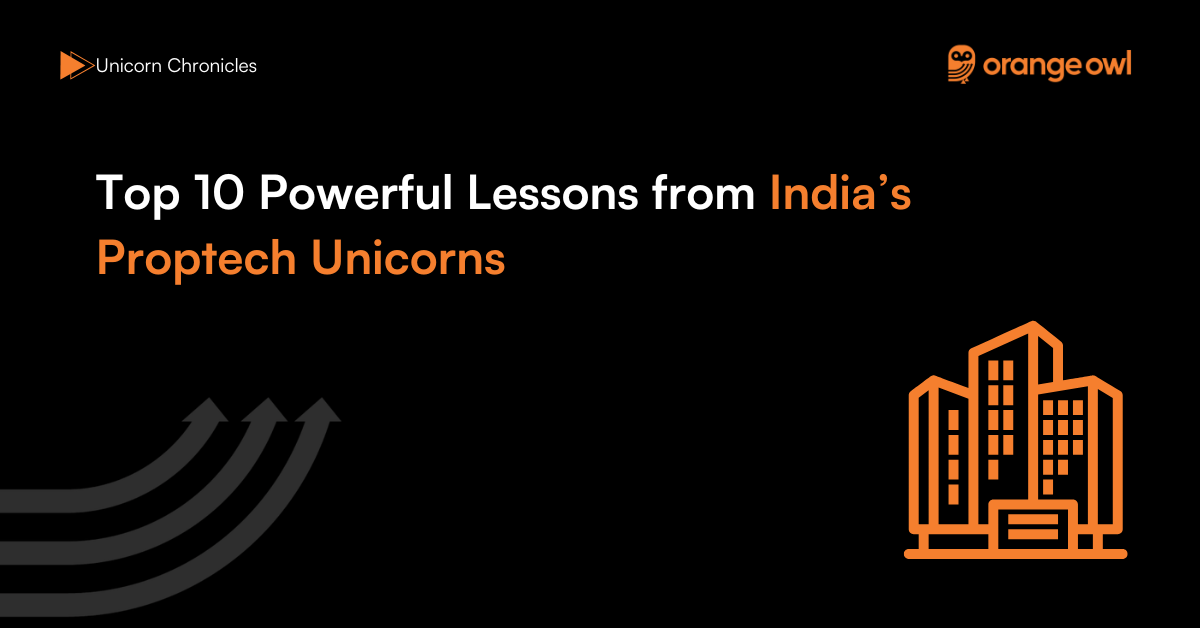What is B2B Intent Data and How to Use it: The Ultimate Guide
Vivek Goel
June 19, 2024

Table of Contents
In the world of B2B marketing, where innovation and customer engagement are key, a new tool is changing how sales and marketing strategies are crafted – intent data. Imagine knowing what your target audience needs and reaching out to them when their interest is highest. This article explores what is b2b intent data and how it is transforming B2B companies, highlights the different types of b2b intent data, and provides insights into best practices, benefits, and top providers.
What is B2B Intent Data?
Types of B2B Intent Data
To effectively harness customer intent, it’s essential to grasp the origins and types of intent data available. Broadly speaking, intent data can be categorized into two main types: first-party and third-party intent data.
First-Party Intent Data
Collected directly from your site, such as forms filled in for gated content or IP addresses collected from visitors.
Example: Tracking which pages a visitor views on your site.
Tip: Use tools like Google Analytics to gather this data.
Best Practice: Regularly review your website analytics to identify patterns and trends in visitor behavior.
Third-Party Intent Data
Collected from external sources like other websites and platforms.
Example: A potential customer reading articles about industry solutions on a third-party site.
Tip: Use services like Bombora to get this data.
Best Practice: Integrate third-party data with your CRM to enhance your understanding of potential customers’ needs and interests.
Four Main Types of B2B Intent Data
1. Search Intent Data
Description: Captured when someone enters a keyword or phrase into a search engine (e.g., Google, Bing).
Example: If you offer marketing software, you might observe that your target audience is actively searching for “effective strategies to boost website traffic.”
How to Leverage:
- Research the keywords your target audience is searching for and use them in your content.
- Use Google AdWords to run ads targeting these keywords.
- Monitor your SEO efforts to ensure your website appears in search results for these keywords.
2. Engagement Data
Description: Information on the level of engagement users have with a particular piece of content, such as reading, sharing, or commenting.
Example: If a user shares your blog post on social media, it could indicate interest in your product or service.
How to Leverage:
- Monitor your social platforms where your target audience is active.
- Use engagement data from email marketing campaigns to segment your subscribers and target them with relevant content.
- Run targeted ads for those users who have engaged with your content in the past.
3. Firmographic Data
Description: Information about a prospective company, such as its size, industry, location, and revenue.
Example: Targeting small businesses in the healthcare industry if your ideal customer fits this demographic.
How to Leverage:
- Use business directories to research companies in your target market.
- Segment your marketing and sales efforts based on firmographics.
- Create content tailored to the needs of specific industries or company sizes.
4. Technographic Data
Description: Information about a prospective company’s technology infrastructure, such as the software it uses, hardware, and networks.
Example: If you sell CRM software, knowing if potential customers are using an outdated system or a competing tool can be crucial.
How to Leverage:
- Use surveys and questionnaires to identify companies using software similar to what you offer.
- Target your marketing and sales efforts based on this information.
- Create content tailored to the technical needs of specific industries or company sizes.
Top 10 Benefits of Using B2B Intent Data
1. Personalization that Wows
Intent data takes personalization to the next level by enabling highly targeted marketing messages. By understanding the specific needs and interests of your audience, you can tailor your communications to resonate deeply with them.
- Example: A B2B software provider can tailor its message to a potential customer who recently searched for “scalable CRM solutions.”
- Stat: 83% of marketers use buyer intent to create relevant content for their audience, improving engagement and conversion rates (TechTarget, 2020).
2. Timing Perfected
Engaging with prospects at the right time can turn potential interest into a successful conversion. Intent data helps you identify the perfect moment to reach out.
- Example: An Email Marketing Automation provider contacts a lead right after they attend a webinar on “Mastering Email Campaigns.”
- Stat: Prospects spend 50% of their time seeking information from third-party sources, highlighting high-intent moments for engagement (Gartner, 2020).
3. Boosted Conversion Rates
Converting leads into loyal customers is the ultimate goal, and intent data plays a crucial role in this process. It helps prioritize leads and tailor messages that drive conversions.
- Example: An e-commerce platform identifies a lead’s interest in “user-friendly checkout experiences” and highlights these features in their communication.
- Stat: 55% of marketers saw an increase in lead conversions when using intent data (Demand Science, 2022).
4. Insights to Drive Innovation
Intent data provides valuable insights that can fuel product innovation and market strategies. It helps you stay ahead of market trends and meet evolving customer needs.
- Example: A Project Management tool sees a rise in searches for “remote team collaboration tools” and introduces new features to meet this demand.
- Stat: 47% of organizations use intent data to inform and enable sales, advertising, and digital marketing initiatives (TechTarget, 2020).
5. Outshine the Competition
In a competitive B2B market, differentiation is essential. Intent data helps you stand out by allowing you to craft targeted messages that address specific customer concerns and needs.
- Example: A Cloud Storage provider sees an increase in searches for “data security in cloud solutions” and crafts targeted messages addressing these concerns.
- Stat: 97% of B2B marketers believe intent data gives firms a competitive edge (Bombora, 2021).

6. Enhanced Lead Prioritization
By identifying and prioritizing high-intent leads, your sales team can focus their efforts on prospects most likely to convert, improving efficiency and success rates.
- Example: A B2B IT services firm uses intent data to identify companies researching “IT infrastructure upgrades” and prioritizes these leads for follow-up.
- Stat: Half of sales leaders use intent data to improve account prioritization (Demand Science, 2022).
7. Shorter Sales Cycles
Intent data can significantly shorten the sales cycle by ensuring that sales teams engage with prospects at the most opportune times, reducing the time to close deals.
- Example: A sales team at a marketing automation company identifies clients engaging with content about “personalized email marketing” and targets them with customized proposals.
- Stat: 96% of companies have successfully achieved their goals using intent data, including shortening sales cycles (Bombora, 2021).
8. Improved ROI
Using intent data helps in creating more effective marketing strategies, leading to better ROI by focusing efforts on the most promising leads and campaigns.
- Example: A B2B logistics firm removes inactive subscribers and corrects outdated information, improving deliverability and engagement.
- Stat: Over 40% of B2B sales reps use intent data to enrich their CRM, leading to improved ROI (Demand Science, 2022).
9. Higher Quality Leads
Intent data helps in generating higher-quality leads by identifying prospects with a strong likelihood of conversion based on their online behaviors and interests.
- Example: A SaaS company targets leads showing high interest in “advanced analytics tools” with tailored marketing efforts.
- Stat: Companies plan to use intent data to generate higher-quality leads (57%), enhance target account lists, and build brand awareness (TechTarget, 2020).
10. Comprehensive Market Understanding
Intent data offers a comprehensive view of market trends and customer behaviors, helping companies make informed strategic decisions.
- Example: A B2B financial services firm uses intent data to stay updated on market trends and customer needs, informing their marketing and product development strategies.
- Stat: By the end of 2022, more than 70% of B2B marketers will utilize third-party intent data to target prospects or engage groups of buyers (Gartner, 2020).
Intent data is a powerful tool guiding B2B companies toward smarter and more effective sales and marketing strategies. With personalization, perfect timing, boosted conversion rates, innovation-driving insights, and the ability to outshine competitors, intent data is vital for business growth. Embrace intent data to anticipate customer needs, stay ahead of trends, and make a lasting impact.
How to Use B2B Intent Data
Intent data can revolutionize how you approach marketing, sales, and product development. Here’s how you can leverage it effectively:
Personalized Marketing Campaigns
Using intent data, you can craft marketing campaigns that resonate deeply with the specific pain points of potential customers. This data helps you understand what your audience is looking for and tailor your messages accordingly.
Strategy: Use insights from intent data to create highly relevant content and marketing messages. For example, if your intent data indicates that a segment of your audience is searching for “cloud-based CRM solutions,” you can develop targeted campaigns highlighting the benefits of your cloud-based CRM features. Personalization can extend to email marketing, social media ads, and even your website’s landing pages, ensuring that every touchpoint addresses the specific needs of different audience segments.
Example: A B2B cybersecurity company notices through intent data that potential customers are increasingly concerned about “data breaches in remote work.” The company can create a series of blog posts, webinars, and email campaigns focusing on remote work security, thus directly addressing the identified pain points and enhancing engagement.
Content Strategy Enhancement
Developing content that directly addresses the queries and concerns expressed through intent data analysis can significantly improve your content strategy. By knowing what topics and issues are top-of-mind for your audience, you can create content that is both timely and relevant.
Strategy: Tailor your content to meet the specific needs and interests of your target audience. This could involve writing blog posts that answer frequently searched questions, producing in-depth guides on trending industry topics, or creating videos that demonstrate how to solve common problems.
Example: An enterprise software company discovers through intent data that there is a high volume of searches for “integrating AI into business processes.” The company can respond by creating comprehensive guides, case studies, and how-to videos on AI integration, positioning themselves as thought leaders and solution providers in this space.
Sales Prospecting Precision
Intent data equips your sales team with the insights needed for more meaningful conversations with potential clients. It helps prioritize leads based on their likelihood to convert and enables sales reps to tailor their outreach based on specific interests and behaviors.
Strategy: Use intent data to prioritize leads and personalize your outreach. For instance, if the data shows that a particular company has been researching “cloud security solutions,” your sales team can prioritize this lead and approach them with a tailored pitch that emphasizes your company’s strengths in cloud security.
Example: A sales team at a marketing automation company identifies that several potential clients have been engaging with content about “personalized email marketing.” The sales reps can then reach out with customized proposals that highlight how their platform can enhance email personalization, thereby increasing the chances of conversion.
Product Development Alignment
Aligning your product development efforts with the demands and intentions of your target audience ensures that your offerings remain relevant and competitive. Intent data provides insights into what features or improvements your customers are looking for.
Strategy: Integrate insights from intent data into your product development roadmap. By regularly analyzing the data, you can identify which features are most desired by your target audience and prioritize their development. This proactive approach ensures that your products evolve in line with market needs.
Example: A project management tool company finds through intent data that there is a growing demand for “collaboration features for remote teams.” The company can prioritize developing these features, ensuring that their product meets current market demands and stays ahead of competitors.
Additional Considerations for Using Intent Data
Lead Scoring
Intent data can significantly enhance your lead scoring process by providing a deeper understanding of a prospect’s readiness to buy. By integrating intent data with your CRM, you can assign higher scores to leads showing strong buying signals, ensuring your sales team focuses on the most promising opportunities.
Example: A B2B IT services firm uses intent data to identify companies researching “IT infrastructure upgrades.” These leads receive higher scores, prompting the sales team to prioritize them for follow-up.
Cold Calling Context
Having insights into what prospects are interested in can make cold calls more effective. With intent data, your sales team can tailor their pitch to address specific pain points and interests, making the conversation more relevant and engaging.
Example: A sales rep at a B2B financial software company knows that a prospect has been searching for “automated financial reporting tools.” The rep can start the call by discussing the benefits of their automated reporting feature, immediately capturing the prospect’s interest.
Customer Retention and Upsell Opportunities
Intent data serves not only to acquire new customers but also to retain existing ones and pinpoint opportunities for upselling. By monitoring the behavior of your current customers, you can detect signs that they might be considering a competitor or looking for additional features.
Example: A SaaS company notices that an existing client has been searching for “advanced analytics tools.” The customer success team can proactively reach out to discuss upgrading their current plan to include the desired features, thereby increasing customer satisfaction and reducing churn.
By leveraging intent data across these various strategies, B2B companies can create more targeted, effective, and efficient marketing, sales, and product development initiatives. This data-driven approach not only enhances customer engagement but also drives higher conversion rates and fosters long-term business growth.
Top 5 B2B Intent Data Providers
Partnering with the right intent data provider is important. Here are five top providers:
1. Bombora
Bombora is recognized for its B2B intent data solutions, offering valuable insights into the research interests of your target audience.
Best Practice: Integrate Bombora’s data with your CRM to enhance your sales and marketing efforts.
2. 6sense
Focused on predictive intelligence, 6sense offers intent data that helps prioritize leads and personalize interactions.
Best Practice: Use 6sense to identify high-intent accounts and focus your resources on the most promising leads.
3. ZoomInfo
ZoomInfo offers intent data as part of its B2B solutions, enabling you to identify potential customers.
Best Practice: Leverage ZoomInfo’s comprehensive database to enrich your prospect profiles and improve targeting accuracy.
4. G2 Intent
G2 leverages data from its software review platform, providing insights into software categories and vendor comparisons.
Best Practice: Use G2’s data to identify prospects researching your product category and engage them with targeted content.
5. KickFire
Specializes in IP address intelligence, KickFire helps identify companies visiting your website.
Best Practice: Integrate KickFire with your web analytics to identify high-intent visitors and tailor your outreach.
Check out other top marketing tools.
Common Sources of B2B Intent Data
1. Ads/Bidstreams
Ad platforms such as Google Ads and Bing Ads collect data on the keywords users search for before clicking on an ad. This information reveals what potential customers are interested in, based on the search terms they use. For example, if users frequently search for “B2B CRM solutions” before clicking on your ads, this indicates a strong interest in CRM software for B2B applications.
How to Leverage: Use the keyword data from tools like Google Keyword Planner to target ads specifically at users who have shown an interest in your type of software. Create marketing and sales content tailored to these interests. For instance, you can develop ads that highlight how your CRM software addresses common pain points or offers unique features sought by these users. This customized strategy enhances the chances of engaging users and achieving conversions.
2. Search Engines
Search engines like Google and Bing enable businesses to target buyers through the keywords they use in searches. By understanding which keywords are being used by your target audience, you can better tailor your SEO and content strategies.
How to Leverage: Optimize your website for the keywords that buyers use when searching for solutions similar to yours. This involves conducting keyword research to identify high-traffic search terms relevant to your business. Incorporate these keywords into your website content, blog posts, and social media updates to improve your search engine rankings and attract more qualified leads. Tools like Google Trends can help you track keyword popularity over time.
3. Marketing Content
Segment buyers into different lists based on the content they consume, such as blog posts, eBooks, webinars, and whitepapers. By tracking which types of content are most popular with different segments of your audience, you can gain insights into their specific interests and needs.
How to Leverage: Provide targeted information about your products or services to these segmented lists. For example, if a particular group frequently downloads content related to advanced analytics, you can create targeted email campaigns or retargeting ads that highlight your advanced analytics features. This personalized approach can significantly increase user engagement and boost conversion rates.
4. Web Traffic
Analyzing web traffic involves examining how visitors interact with your website, including which pages they visit, how long they stay, and what actions they take. This information offers valuable understanding into the requirements and preferences of your potential buyers.
How to Leverage: Use web analytics tools like Google Analytics to monitor your website traffic. Identify which pages are most popular and what content drives the most engagement. Use this information to target and segment your prospects more effectively. For example, if a significant number of visitors spend time on your product comparison pages, consider creating targeted campaigns that highlight your product’s advantages over competitors.
5. Internet Scraping
Internet scraping involves using bots to collect data from various websites. This technique can help identify users who are showing high intent to purchase based on their online behavior.
How to Leverage: Gather information on prospects who visit competitor websites, forums, or review sites frequently. Use tools like Scrapy to automate the data collection process. Create targeted lists for marketing and sales outreach based on this data. For instance, if you identify users who are actively researching solutions in your industry, you can reach out to them with tailored offers or informational content that addresses their specific needs.
6. Third-Party Sources
Platforms like Capterra, Software Advice, and GetApp provide meaningful intent signals by offering comprehensive product profiles, user reviews, and comparisons. These platforms help buyers shortlist and select the best software solutions for their needs.
How to Leverage: Use the data from these third-party sources to target buyers at different stages of the funnel. For example, if a prospect is frequently comparing products on these platforms, they are likely in the decision-making stage. Engage them with detailed case studies, testimonials, and product demos that address their specific concerns and highlight your solution’s strengths. This targeted approach can help you move prospects through the funnel more effectively and increase your chances of conversion.
By leveraging these common sources of intent data, B2B companies can gain deeper insights into their target audience’s behavior and preferences, allowing for more precise and effective marketing and sales strategies.
5 Key Considerations When Choosing B2B Intent Data
When choosing intent data for your B2B company, it’s essential to consider several key factors to ensure you make the most informed decision:
1. Quality
The accuracy and currency of the data you use are paramount. High-quality data ensures that your marketing and sales strategies are based on reliable insights, leading to better decision-making and outcomes. For example, a B2B software company targeting enterprise clients needs precise and up-to-date information to identify potential leads effectively. Choosing a provider known for offering high-quality data is crucial to avoid wasted efforts on outdated or incorrect information.
2. Quantity
Having access to a substantial volume of intent data is essential for proper segmentation and targeting. A B2B marketing firm, for instance, requires enough data to segment its audience accurately and tailor its campaigns to different buyer personas. Ensuring that your data provider can supply a sufficient amount of intent data allows for more granular and effective targeting.
3. Relevance
The relevance of the intent data to your specific industry and business needs cannot be overstated. Data that closely aligns with your industry will yield more actionable insights and lead to more effective marketing strategies. For example, a B2B healthcare technology provider should prioritize intent data that is specific to the healthcare industry to better understand and meet the needs of its target audience.
4. Ease of Use
Intent data should be straightforward to use and understand, allowing your team to quickly integrate it into their workflows. A user-friendly platform can significantly enhance the efficiency of your marketing and sales efforts. For instance, a B2B financial services firm might benefit from a data provider that offers intuitive dashboards and easy-to-interpret analytics, enabling the team to act swiftly on the insights gained.
5. Cost
The cost of intent data should fit within your budget while offering a good return on investment (ROI). It’s important to select a provider that provides competitive pricing without compromising on the quality and quantity of data. For example, a small B2B startup with limited marketing funds should look for a cost-effective intent data solution that still meets its needs for high-quality, relevant data.
By considering these factors – quality, quantity, relevance, ease of use, and cost – you can choose an intent data provider that will best support your B2B marketing and sales strategies, leading to more effective and efficient outcomes.
Conclusion
B2B Intent data is a powerful tool guiding companies toward smarter and more effective sales and marketing strategies. With personalization, perfect timing, boosted conversion rates, innovation-driving insights, and the ability to outshine competitors, intent data is vital for business growth. Embrace intent data to anticipate customer needs, stay ahead of trends, and make a lasting impact.
By following best practices and leveraging top intent data providers, B2B companies can unlock new opportunities for growth and success. B2B Intent data empowers you to understand your audience better, engage them at the right time, and deliver personalized experiences that drive conversions. Start using intent data today and transform your marketing playbook for the better.
B2B companies can use intent data to identify and prioritize high-intent leads by monitoring online behaviors that indicate purchase interest. This data helps marketing and sales teams focus their efforts on leads that are more likely to convert, thereby improving lead generation efficiency and effectiveness.
Best practices for integrating intent data into a B2B marketing strategy include segmenting your audience based on intent signals, personalizing content and outreach, aligning sales and marketing efforts, and continuously analyzing and optimizing your campaigns. Utilizing tools like CRM systems and marketing automation platforms can enhance the effectiveness of intent data.
Common challenges include data quality issues, making the data actionable, and aligning sales and marketing teams. To overcome these, companies should choose reliable intent data providers, invest in data analytics tools, and foster close collaboration between sales and marketing departments to ensure data is used effectively.
Intent data can shorten the B2B sales cycle by identifying leads that are already in the consideration or decision-making stages. Sales teams can use this information to engage with these leads at the right time with relevant solutions, reducing the time spent on nurturing and accelerating the conversion process.
B2B companies can measure the ROI of using intent data by tracking key performance indicators (KPIs) such as lead conversion rates, sales cycle length, customer acquisition cost (CAC), and overall revenue growth. Comparing these metrics before and after implementing intent data strategies can provide insights into its effectiveness and financial impact.


